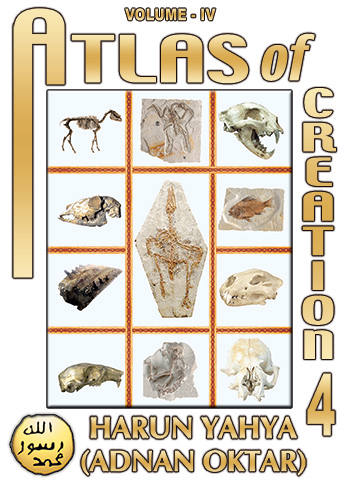Stromatolites:
3.9-Million-Year-Old Living Marvels That Refute The Theory Of Evolution
The oldest known fossils belong to bacteria that lived some 3.9 billion years ago. That is why evolutionists have claimed that the first single-celled bacterium emerged spontaneously, by chance, from inanimate matter. In order to be able to corroborate this myth, Darwinists refer to the first bacterium in question as a “simple” organism. In their eyes, this life form with supposedly simple characteristics, must have been influenced at random by various environmental circumstances and conditions and have undergone changes, always positive, and must have acquired various miraculous characteristics – such as producing its own nutrients and starting to replicate by mitosis from meiosis – again all by chance. But in order for this to transpire that unconscious bacterium would have to go even further and start thinking, it would have to have made various decisions and established colonies. It would also have to be capable of biochemical communications with other bacteria and eventually become the complex life form it is now. This illogical and irrational claim made by Darwinists was widely accepted due to the ignorance of the time, when science had not made much progress, and was heralded as a scientific fact. But this has all changed in the 21st century.
The major scientific advances taking place today have totally undermined the idea of a “primitive first bacterium” because current research in the light of advanced technology has revealed that these, the smallest life forms on earth, are not at all simple, as Darwinists maintain, that they have highly important and complex attributes, and that they could only have been created in a single moment by a sublime Mind and with an incomparable Knowledge. The fact revealed by science is that Allah has created bacteria, like all other living things.
Bacteria Are Essential For Life On Earth
A chemical laboratory made up of elements we cannot see with the naked eye, that works non-stop and supports our survival, is present in all of nature. The bacteria we are considering in this chapter, each one of which is a miracle of creation, are expert chemists that make use of nature as a laboratory. A great many of the features of bacteria are still unknown because the size of these life forms, around 0.001 millimeters (3.93700787 × 10-5 inches), generally makes it impossible to study their internal structures properly. However, the available data still describe the systems in these life forms to us.
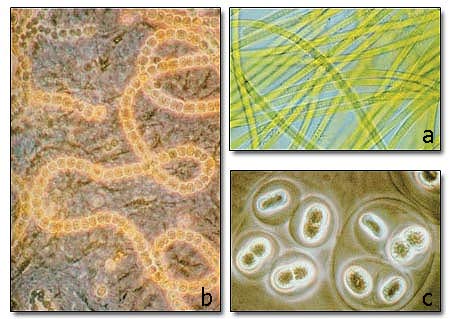
The pictures show three types of cyanobacteria. (a: Nostoc, b: Oscillatoria, and c: Gleocapsa). These bacteria, which live in clean waters, have exceptionally complex chlorophyll. By means of these systems, which are almost as complex as plant chloroplasts, cyanobacteria perform the process of photosynthesis in nature. Nostoc cyanobacteria also play an important role in nitrogen transformation and the "fixing" of atmospheric nitrogen.
Bacteria are not primitive, as evolutionists like to claim. On the contrary, they possess complex systems that prove that they could not have come into being through a gradual process of evolution. There are many species of bacteria in nature, all with different characteristics.
Cyanobacteria represent the most complex group of bacteria, which exhibit these different features. However, this description is still far from describing cyanobacteria’s characteristics and the wonderful functions they perform. Cyanobacteria possess very special cellular architectures and complex intra-cellular communications systems.
Even 3.9 billion years ago, cyanobacteria were marvelous and fully equipped life forms capable of making photosynthesis, carrying out nitrogen fixation (nitrogen that cannot be used in a gaseous form assuming the form of usable compounds), capable of movement without the bacterial whip (flagella) and using a string of proteins in order to make such motion possible.
The Glorious Characteristics Of Cyanobacteria That Refute Evolution
Cyanobacteria, also known as blue-green algae, are the oldest known prokaryotes, single-celled organisms, obtaining their energy through photosynthesis.1 These life forms can manufacture the carbon they use for processes within the cell from the carbon dioxide in the atmosphere. At the same time, they are able to fix nitrogen gas in molecular form. The fact that these processes take place in the same place requires careful reflection and totally refutes the evolutionists idea that these life forms are “primitive.”
The enzyme nitrogenase, which is responsible for nitrogen fixation, is exceedingly sensitive to oxygen. For that reason, nitrogen fixation and the process of photosynthesis, which requires oxygen, should not be able to take place at the same time in cyanobacteria cells. In order to overcome this difficulty, the filaments in some cyanobacteria restrict the nitrogen fixation process with a special kind of cell known as heterocysts.
With their unique structure, heterocyst cells enable these two incompatible processes to be performed by the cyanobacteria.
In order to restrict the entry of oxygen, heterocyst cells are covered with a special sheath containing glycolipid and polysaccharide, a protective homogeneous envelope. A layer four nanometers thick develops through the interaction of waterproof chains, and this restricts the permeability of dissolved substances. Heterocysts have four separate membranes consisting of double-layer lipids, and these have different structures and functions.
In this way, carbon dioxide fixing through photosynthesis and nitrogen fixation in an oxygen-free environment, which cannot happen at the same time, are separated from one another, and cyanobacteria are able to discharge their functions.
Cyanobacteria Fossils: An Insoluble Dilemma For Evolutionists
Rock strata in the Apex Chert region of Australia contain cyanobacteria fossils, or stromatolites (stromatoliths), dating back 3.9 billion years.
Stromatolites form in shallow water with the accumulation and freezing of the sediment of micro-organisms such as cyanobacteria. Stromatolites began forming in the Precambrian Period and are formed by calcium carbonate particles (limestone) carried by the sea adhering to the filaments formed by blue-green algae.2 These structures are rich in chlorophyll. Over the geological ages they formed in globes or domes of various sized immediately beneath the surface of the sea.
Human beings and animals possess no mechanism allowing them to make direct use of solar energy. That energy can only be obtained by being synthesized as a result of the process of photosynthesis performed by green plants and micro-organisms. Cyanobacteria species that make photosynthesis produce more than half the oxygen in the atmosphere. The energy that these organisms manufacture with solar energy is stored in the form of simple sugars. This sugar is needed for the biochemical reactions essential for the survival and growth of living things on Earth, and also for respiration.
As well as oxygen and carbon dioxide, living things also need nitrogen (N2) in order to survive. Nitrogen represents one of the fundamental building blocks in the living body, especially in the structure of nucleic acids, proteins and vitamins. The Earth's atmosphere consists of approximately 78% nitrogen. However, despite their needing it, living things cannot absorb this nitrogen in the air into their bodies. This gas has to be converted in some way into a form that living things can make use of and then recycled back into the atmosphere if it is not to run out. That need is again met by microscopic bacteria.
The living things that must first absorb nitrogen from the air are plants. Plants cannot use nitrogen in gas form. Nitrogen is converted by nitrite bacteria into nitrite, and nitrate bacteria then convert that nitrite into nitrate, a form that plants can use.
In carrying out the nitrogen cycle, the bacteria that evolutionists describe as “simple” actually function like living chemical laboratories, as with photosynthesis, and have been performing complex chemical reactions, beyond the comprehension of anyone without a close knowledge of chemistry, since the day they were first created.
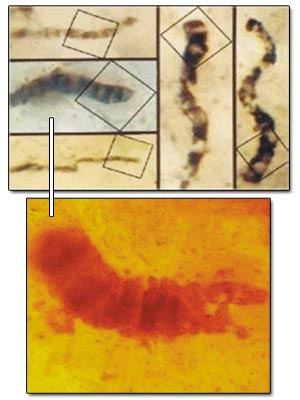
Fossil remains of the world’s oldest micro-organism, dating back 3.9 billion years, have been found in Australia’s Apex Chert region. The cyanobacteria fossils at the top and left were discovered in Apex Chert and are 3.5 billion years old.
|
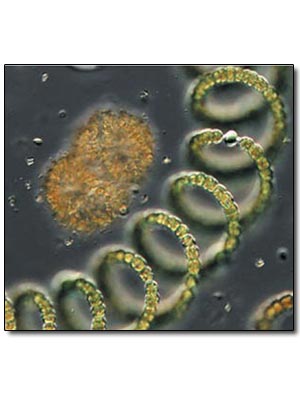
One in every ten cells in the filamentlike cyanobacteria in the picture above is known as a heterocyst, and it is these cells, which are completely insulated from oxygen, that perform the task of fixing nitrogen.
|
Some of the characteristics of cyanobacteria, those marvelous micro-organisms, that refute the claim of the theory of evolution that life forms came into beings by chance, may be summarized as follows:
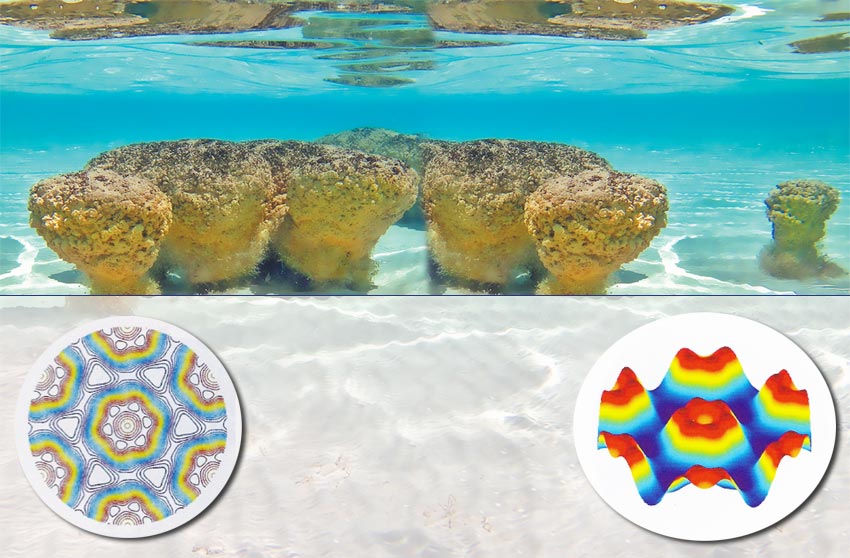
The picture above shows images of the hexagonal and symmetrical “S layer” in cyanobacteria from above and from the side.
The theory of evolution has no meaningful answer to the highly esthetic appearance and symmetry in the architecture of these living things. It is impossible for this symmetry and flawless system to come about by chance.
The flawlessness in these tiny organisms clearly shows the creation of our Almighty Lord, the sublime Creator.
|
The stromatolite fossil record is exceedingly rich, and they have been around in various environments on Earth for some four billion years. They were initially discovered in Shark Bay, Australia in 1956. They are also found in the Bahamas, the Indian Ocean, Africa and the USA.
Stromatolites have a bacteria population of 3 billion per square meter. When these combine with sediments and organic materials and gradually grow to 10 million times their own size, they build structures up to 1.5 meters (5 feet) in size. Since they grow very slowly, a one meter stromatolite will be around 2,000 years old.8
The giant activities of cyanobacteria, those marvelous micro-organisms:
• Cyanobacteria by themselves produce 30% of the Earth’s annual amount of oxygen3; that figure is equivalent to the amount produced by all the green plants on Earth.
• These bacteria are very small in size, but their production is enormous. There are more than 100 of them in a liter of water, and they account for 10% to 20% of the productivity of the oceans. Despite being invisible, they predominate over a large part of the Earth.
• This form of bacterium is capable of performing very different processes (such as photosynthesis, nitrogen fixation (the process whereby nitrogen is turned into a form usable by living things) and respiration, within a single cell. This requires a matchless cell membrane system, as outlined above. For example, the bacteria need an oxygen-free environment for nitrogen fixation, but an oxygen-rich environment for all the other processes, and these require very different cell membranes. This architecture makes cyanobacteria one of the most complex members of the bacterial kingdom.4
• In 1980, cyanobacteria were observed to possess a “circadian” clock.5 A circadian clock is the automatic regulation of the body according to its external environment, seen in multi-celled organisms. Cyanobacteria have been observed to engage in photosynthesis and respiration by absorbing oxygen into their cells for 12 hours a day, while they perform nitrogen fixation for the other 12 hours.
• Cyanobacteria are able to move in water without using flagellae (the bacterial whip). The secret behind the way these organisms can move without using any body part has still not been adequately explained, despite ongoing research for the last 20 years. The hexagonal layer known as the “S layer,” which makes up the most external layer of the cell, is three-dimensional and symmetrical. This layer is thought to play a role in cell movement. Because when the gene “swm6,” which expresses that symmetry, is subjected to mutation, the cell has been observed to be unable to move.6
• Cyanobacteria are capable of manufacturing anticarcinogenic, antiviral and UV-protective substances. These characteristics mean they are used in genetic studies intended to benefit human beings. For example, the antiviral protein Cyaniovirin-N produced by the Cyanobacterium species Nostoc ellipsosporum neutralizes the HIV virus. This protein possesses the ability to adhere to the oligosaccharide structures that enable the HIV virus to attach to the cells. Studies on this subject are still being planned.7
Bacteria are not only found in the seas or water sources. They are also agents present in all living things, from the human body to termites living underground to the root hairs on a plant. These organisms have spread everywhere on Earth and have been discharging their functions with the same perfection for billions of years. All this of course points to one single truth: Creation.
The proponents of the theory of evolution are in fact perfectly well aware that these organisms are not simple at all. That is why they are in a constant state of difficulty and doubt when they try to describe the characteristics and mechanisms possessed by the perfect organisms in question. Evolution is an unscientific theory unable even to account for the existence of a micro-organism.
The science and technology that have made such advances in the 21st century have revealed, under the scanning electron microscope, a brand new world that again refutes the theory of evolution. Yet another has been added to the increasingly lengthy list of questions for Darwinists about life on Earth. Every piece of research, every new finding, every characteristic we encounter in living things, is a means whereby we can discover the flawless artistry created by Allah in invisible things and whereby we can properly appreciate it.
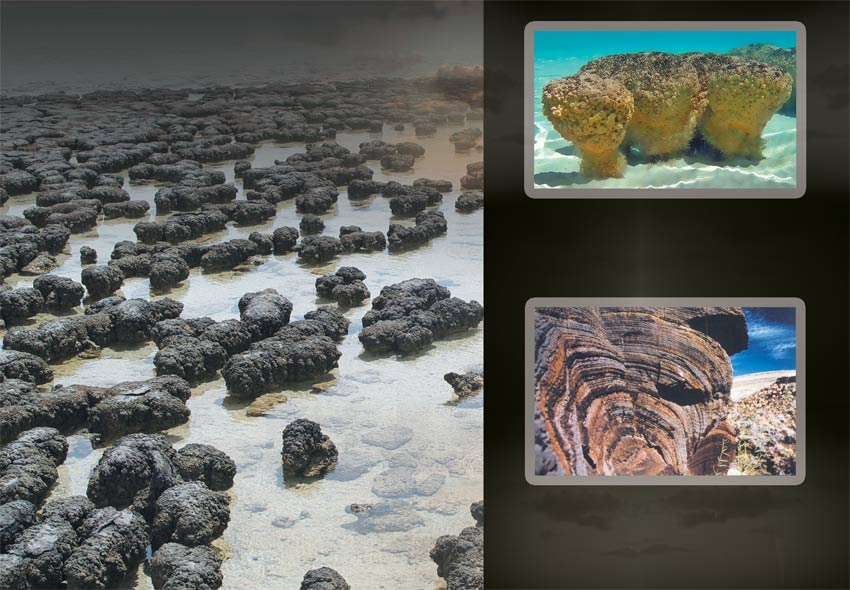
Bacterial strata gradually darken because of their sediments and move upward in order to reach the sunlight. As seen in the picture, one layer is added onto another and they eventually produce very large towers.
These fossil stromatolites in the Pilbara region of Australia date back to the Precambrian Era. The gray, convoluted layers show how stromatolites grow upward.
|
The stromatolites on this page have been living in the Hamelin Pool Basin of Shark Bay, Australia for 4,000 years.
Stromatolite fossils dating back 3.9 billion years can be found in other regions of Australia. There is absolutely no difference between these 3.9-billion-year-old fossil stromatolites and those living today. These organisms have never evolved.
Fossil Stromatolite

Period:Precambrian
Age: 2.4 - 2.2 billion years
Region:Michigan, USA
This stromatolite, one of the oldest-known microfossils in the fossil records, was found in Michigan in the United States of America.
This stromatolite fossil, some 2.4 billion years old, is a member of the cyanobacteria colonies, the oldest-known micro-organisms of Earth. Examination of stromatolites provides valuable information about the climate, geology, biodiversity and geography of the Earth billions of years in the past.
Layers gradually form as calcium carbonate (limestone) builds up on the fibers of growing bacteria. Bacteria initiate this build-up by making photosynthesis using carbon dioxide from the water around.
Particles and mineral dissolved in the water are trapped in the adhesive fluid surrounding the bacteria and continue to produce new strata by growing upward.
This process is repeated over and over again, and sedimentary layers form. The process is still continuing today.
Fossilized stromatolites dating back 3.9 billion years can be found in the sedimentary layers on all continents.
Fossil Stromatolite
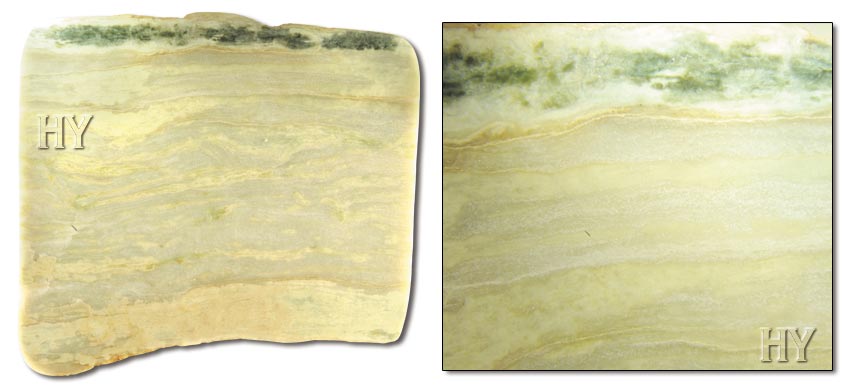
Period: Precambrian
Age: 2.4 - 2.2 billion years
Region: Michigan, USA
This fossil was unearthed in the state of Michigan, USA, and is an example resembling marble of stromatolitic materials belonging to when life first appeared on Earth.
Marble is a metamorphosed form of limestone. The green color so attractive to the eye is the result of serpentine, which forms when there is a high level of magnesium in the limestone. 9
Fossil stromatolites are colonies of cyanobacteria, the oldest known organisms. These bacteria that lived billions of years ago, seen fossilized among rock strata, have highly complex structures and are capable of manufacturing oxygen. The processes that these organisms carry out in their micro-bodies, too small to be seen with the naked eye, exhibit a perfection that today’s advanced technology is nowhere near approaching. Cyanobacteria, which Darwinists claim are “primitive early life forms,” make photosynthesis using sunlight and convert water into oxygen molecules as well as protons and electrons. The structures known as thylakoids they use for photosynthesis are located within the folds of the cell membrane. Thylakoids have special antennae known as phycobilisomes that collect light for photosystems. It is clear that such an architecture is not at all “primitive.”
Considering both their structures and the processes they perform, these organisms, which date back 3.9 billion years, are not at all primitive, but have been highly complex ever since the moment they were first created.
Fossil Stromatolite
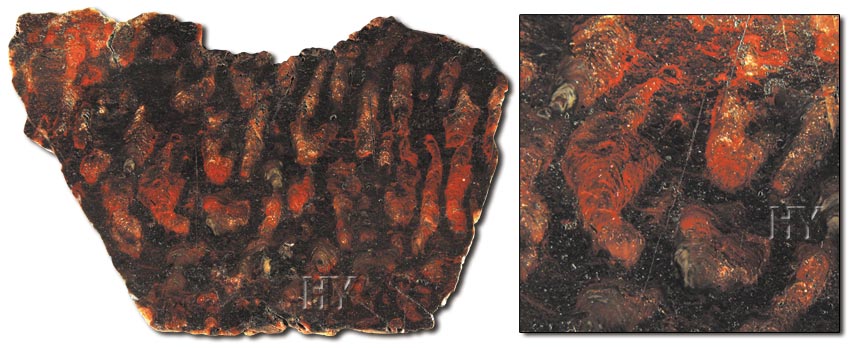
Period: Precambrian
Age: 2.4 billion years
Region:USA
This 2.4-billion-year Precambrian fossil stromatolite possesses striking colors and patterns. This species’ red color, known as Tiger iron, is the result of jasper and black hematite (mineral iron). The contrasting bands of color form a striking pattern. It is generally used in jewelry and for decoration. Tiger iron essentially consists of silicon dioxide and is colored by iron oxide. 10
Cyanobacteria’s moving mechanism involves highly detailed and unique processes.
In the daytime, cyanobacteria remain close to the surface for photosynthesis, and at night they sink to the bottom to gather nutrients. They use gas vacuoles (empty spaces) to do this and constantly change their locations in the water.
In contrast to other bacteria, cyanobacteria employ a slow glide in order to move; but since they have no whips, the mechanisms by which these organisms move is still not fully understood.
Complex proteins play a role in the slow, gliding motion that enables the cells to change location, but the structure of the “engine” and how the chemical compounds work is still a mystery. Nonetheless this mechanism has remained unchanged for billions of years, and has never altered.
|
